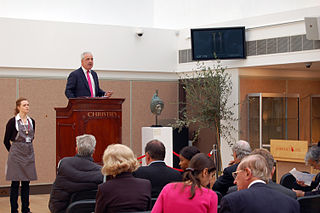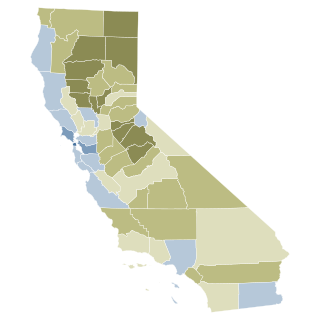Related Research Articles

Proposition 13 is an amendment of the Constitution of California enacted during 1978, by means of the initiative process. The initiative was approved by California voters on June 6, 1978. It was upheld as constitutional by the United States Supreme Court in the case of Nordlinger v. Hahn, 505 U.S. 1 (1992). Proposition 13 is embodied in Article XIII A of the Constitution of the State of California.
A property tax is an ad valorem tax on the value of a property.
Market value or OMV is the price at which an asset would trade in a competitive auction setting. Market value is often used interchangeably with open market value, fair value or fair market value, although these terms have distinct definitions in different standards, and differ in some circumstances.
Real estate appraisal, property valuation or land valuation is the process of developing an opinion of value for real property. Real estate transactions often require appraisals because they occur infrequently and every property is unique, unlike corporate stocks, which are traded daily and are identical. The location also plays a key role in valuation. However, since property cannot change location, it is often the upgrades or improvements to the home that can change its value. Appraisal reports form the basis for mortgage loans, settling estates and divorces, taxation, and so on. Sometimes an appraisal report is used to establish a sale price for a property.
An ad valorem tax is a tax whose amount is based on the value of a transaction or of property. It is typically imposed at the time of a transaction, as in the case of a sales tax or value-added tax (VAT). An ad valorem tax may also be imposed annually, as in the case of a real or personal property tax, or in connection with another significant event. In some countries, a stamp duty is imposed as an ad valorem tax.
The State of New Hampshire has a republican form of government modeled after the Government of the United States, with three branches: the executive, consisting of the Governor of New Hampshire and the other elected constitutional officers; the legislative, called the New Hampshire General Court, which includes the Senate and the House of Representatives; and the judicial, consisting of the Supreme Court of New Hampshire and lower courts.

Tax revenue is the income that is collected by governments through taxation. Taxation is the primary source of government revenue. Revenue may be extracted from sources such as individuals, public enterprises, trade, royalties on natural resources and/or foreign aid. An inefficient collection of taxes is greater in countries characterized by poverty, a large agricultural sector and large amounts of foreign aid.
Highest and Best Use, or highest or best use (HBU), is a concept that originated with early economists such as Irving Fisher (1867-1947), who conceptualized the idea of maximum productivity. One of the earliest citations of the term is found in the Minutes of the Maine Legislature as early as 1831 in speaking about the assessment and valuation of real estate: "...the land was classified preceding such change of use, had such real estate been assessed at its highest and best use..." It is the concept in real estate appraisal that shows how the highest value for a property is arrived at. In any case where the market value of real property is sought, that value must be based on its highest and best use. Highest and best use is always that use that would produce the highest value for a property, regardless of its actual current use.
Farmland development rights in Suffolk County, New York began in 1975 in Suffolk County as the state of New York began a program to purchase development rights for farmland to insure they remained as farms and open space rather than being developed for housing.
In the United States, a special assessment is a charge that public authorities can assess against real estate parcels for certain public projects. This charge is levied in a specific geographic area known as a special assessment district (SAD). A special assessment may only be levied against parcels of real estate which have been identified as having received a direct and unique "benefit" from the public project.

Act 60, known as "The Equal Educational Opportunity Act", was a Vermont law enacted in June 1997 by the Vermont legislature intended to achieve a fair balance of educational spending across school districts, independent of the degree of prosperity within each district. The law was in response to a Vermont Supreme Court decision in the Brigham vs. State of Vermont case, wherein the court ruled that Vermont’s then existing educational funding system was unconstitutional, because it allowed students in towns with higher total property values to receive a higher level of education funding per pupil than students in towns with lower property values. Act 60 was followed by Acts 68 and 130, which addressed some imbalances caused by Act 60.
Tax assessment, or assessment, is the job of determining the value, and sometimes determining the use, of property, usually to calculate a property tax. This is usually done by an office called the assessor or tax assessor.
Community Facilities Districts (CFDs), more commonly known as Mello-Roos, are special districts established by local governments in California as a means of obtaining additional public funding. Counties, cities, special districts, joint powers authority, and school districts in California use these financing districts to pay for public works and some public services.
An Automated Valuation Model (AVM) is a system for the valuation of real estate that provides a value of a specified property at a specified date, using mathematical modelling techniques in an automated manner. AVMs are Statistical Valuation Methods and divide into Comparables Based AVMs and Hedonic Models. Other Statistical Valuation Methods are House Price Indices and Single Parameter Valuations.

Art valuation, an art-specific subset of financial valuation, is the process of estimating the market value of works of art. As such, it is more of a financial rather than an aesthetic concern, however, subjective views of cultural value play a part as well. Art valuation involves comparing data from multiple sources such as art auction houses, private and corporate collectors, curators, art dealer activities, gallerists, experienced consultants, and specialized market analysts to arrive at a value. Art valuation is accomplished not only for collection, investment, divestment, and financing purposes, but as part of estate valuations, for charitable contributions, for tax planning, insurance, and loan collateral purposes. This article deals with the valuation of works of fine art, especially contemporary art, at the top end of the international market, but similar principles apply to the valuation of less expensive art and antiques.

Most local governments in the United States impose a property tax, also known as a millage rate, as a principal source of revenue. This tax may be imposed on real estate or personal property. The tax is nearly always computed as the fair market value of the property times an assessment ratio times a tax rate, and is generally an obligation of the owner of the property. Values are determined by local officials, and may be disputed by property owners. For the taxing authority, one advantage of the property tax over the sales tax or income tax is that the revenue always equals the tax levy, unlike the other taxes. The property tax typically produces the required revenue for municipalities' tax levies. A disadvantage to the taxpayer is that the tax liability is fixed, while the taxpayer's income is not.
The parcel tax is a form of real estate tax. Unlike most real estate taxes or a land value tax, it is not directly based on property value. It funds K–12 public education and community facilities districts, which are usually known as "Mello-Roos" districts. The California parcel tax, in its typical form as a flat tax, is regressive.

The Gallagher Amendment was an amendment to the Colorado Constitution enacted in 1982 and repealed in 2020 concerning property tax. It set forth the guidelines in the Colorado Constitution for determining the actual value of property and the valuation for assessment of such property. The Gallagher Amendment was a legislative referendum drafted by Dennis J. Gallagher, then a state legislator. It was repealed in 2020.

S.7000-A is the name given to the current dominant property tax law in effect in New York State affecting New York City. Surrounding areas such as Nassau County have similar laws. The bill was enacted in 1981 in response to the Hellerstein decision. The law is embodied in Article 18 of the New York State Real Property Law.

California Proposition 15 was a failed citizen-initiated proposition on the November 3, 2020, ballot. It would have provided $6.5 billion to $11.5 billion in new funding for public schools, community colleges, and local government services by creating a "split roll" system that increased taxes on large commercial properties by assessing them at market value, without changing property taxes for small business owners or residential properties for homeowners or renters. The measure failed by a small margin of about four percentage points.
References
- 1 2 ASB Assessing Reference Manual for Taxpayers, Selectmen, and Assessors Archived June 26, 2012, at the Wayback Machine —Section 5.6, Market Value Influences discusses the role of subjective factors in an assessment.
- ↑ AN ACT establishing a committee to study property appraisals of features of land and the view from residential property and unimproved land.
- ↑ HB-245 status
- ↑ "'View tax' and value debated at hearing". Manchester Union-Leader. 2012-01-24. Retrieved 2012-01-24.
- ↑ "Do away with view tax? No, House committee says". Manchester Union-Leader. 2012-02-21. Retrieved 2012-02-21.
- 1 2 "Portugal homes with sea views face higher tax to improve fiscal outlook". The Guardian (from Agence France-Presse). 2016-12-19.